|
| This is an educational web site by Dr. Dale Dubin (Dale Dubin, M.D.), which includes important EKG (ECG) information about EKG tracings, 12 lead EKG's, and cardiac monitors. All web sites offer free PDF downloads.
To order Rapid Interpretation of EKG's, scroll to the bottom of the page. |
|
|
For
physicians, practical understanding of the routine twelve lead EKG
and the display on cardiac monitors, provides an invaluable, diagnostic
skill.
During
the last century, medicine has come to recognize the enormous value
of the standard twelve lead EKG. Few tests have provided the range
of diagnostic utility and accuracy in determining the patient's
medical progress.
Now
every physician is expected to possess a reasonable level of expertise
and skill in electrocardiography. National and state medical board
exams test for competence in electrocardiography, as do most specialty
boards; this is essential medical knowledge for all physicians.
In
emergencies, the EKG is our mainstay for evaluating minute-to-minute
changes in vital cardiac function during life-and-death crises.
One cannot predict where and when spontaneous emergencies will arise.
Regardless of the medical or social circumstances at hand, physicians
are expected to exercise their special knowledge in these critical
situations when a person's life is in jeopardy.
Cardiac
monitors displaying the heart's electrical messages are standard
equipment in critical care and emergency areas. But cardiac monitors
are also utilized throughout hospitals. You are expected to understand
and interpret this information at any instant. Your essential
knowledge
will serve your patients and the medical community well. Don't
be intimidated… understanding is easy!
Physicians
can effortlessly gain a crystal-clear understanding the heart's
electrical messages with one simplified book, Rapid Interpretation
of EKG's, the most popular and most referenced EKG (ECG)
text in the world. The new, updated 6th edition in full color is
now available.
This
classic text, the international best-seller for over thirty-five (35!)
years, is now updated with every printing (updated May, 2007), making it the most current text
available. It stresses understanding rather than memorizing,
so
it instills in you a lifetime of practical knowledge… and the confidence
you need for optimal, professional patient care.
This
web site presents general information to physicians about electrocardiography,
as both paper tracings and cardiac monitor displays. The presentations
on "Memory Images" and "Interactive
Learning"
provide entertaining information that empowers you with very useful,
easily learned, medical knowledge. See how fast you learn! Take
pride in your new knowledge; put it to use immediately. And it is
quite easy to acquire and comprehend, as you will soon see.
The
section, "Life Preserver", demonstrates some EKG signs that
may be present in apparently normal persons, yet the presence of
these simple signs forebodes dangerous medical problems or even
sudden death. By merely being attentive and observing these signs,
you can then refer one of these patients for proper preventative
treatment to become a "Life Preserver." By observation alone, you
can save a meaningful life.
The presentation, "Monitor
Warnings", uses the
most advanced web site technology to portray accurate, animated
reproductions of cardiac monitor warning signs in real time, just
like the cardiac monitor displays that you see in person. Brief,
practical interpretations are provided and carefully explained.
Your computer screen should accurately display these cardiac monitor
warning signs. All physicians need to know these signs in order
to deliver responsible, lifesaving care.
For physicians already experienced with electrocardiography and
cardiac monitors, we present "Tricky
Tracings". And for physicians and physicians in training
who
want to learn more about identifying these common imposters once
the correct answers are posted, we will provide reference page
numbers
for in-depth understanding (to avoid future pitfalls).
We
also provide (free!) a simplified, step-by-step reference for
interpretation
of 12-lead EKG's, the classic Personal Quick Reference Sheets ("Reference
Sheets"),
previously available only by purchasing the book. This reference
describes the standard methodology for interpreting
EKG's. It also contains snips of example tracings… with brief explanations
of each. This valuable quick review is yours to print out or quickly
download as a PDF file. It's your free gift to keep for daily reference
or for your personal library.
This
site is both entertaining and vitally practical for professional
patient care. The download speed depends on your computer. If you've
read the information so far, everything should be ready. But if
your computer requires more time, please be patient, for in the
next few minutes you can easily acquire a wealth of useful information.
Get a cup of coffee, relax, and enjoy the show as you absorb some
practical knowledge.
|
|
The
EKG (ECG), developed in 1901, persists as medicine's most important diagnostic
tool, and it is surprisingly easy to understand and master.
Now
standardized worldwide, the EKG provides critical diagnostic information
to physicians and health-care professionals everywhere.

|

*Updated and revised
May, 2007
|
One
book, Rapid Interpretation of EKG's, has made understanding
the heart's electrical messages very easy.
- Simplified
comprehension that lasts a lifetime!
- The international
best seller for over 35 years!
- Now updated
with each printing*
- Printed
in 46 languages!
- The new,
updated 6th edition is currently available.
|

|
Every page of
Rapid Interpretation of EKG's is illustrated:
- each page
has a large illustration of a simplified concept.
- illustrated
concepts are a permanent memory tool.
|

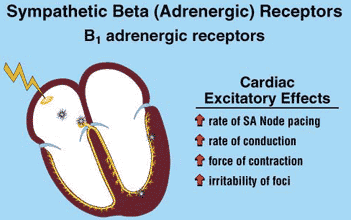
From Rapid Interpretation of EKG's copyright © 2017 COVER Publishing Co. Inc. |
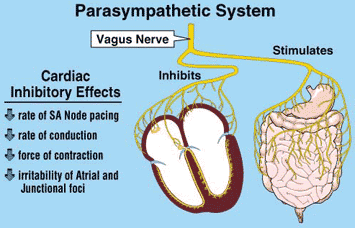
From Rapid Interpretation of EKG's copyright © 2017 COVER Publishing Co. Inc. |
|
Simplified illustrations
(with a caption explaining the concept) associate EKG and physiology
for rapid comprehension through:
- image association
- memorable
analogies
- light and
entertaining examples
|

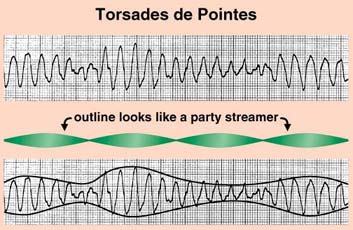
From Rapid Interpretation of EKG's copyright © 2017 COVER Publishing Co. Inc.
Torsades
de Pointes is a rapid ventricular rhythm caused by low potassium,
medications (those that block potassium channels), or congenital
abnormalities (e.g., Long QT Syndrome) that lengthen the QT interval.
The rate is a variable 250 to 350 per minute, in brief episodes.
|
|
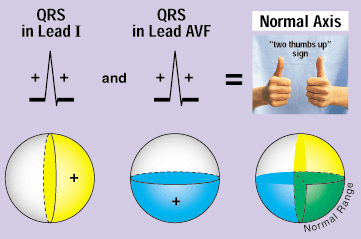
From Rapid Interpretation of EKG's copyright © 2017 COVER Publishing Co. Inc.
Follow
the illustration closely. If the QRS is positive in lead I and also
positive in AVF, the Vector points downward and to the patient's
left. This is the normal axis range; the area that is both yellow
and blue (yellow plus blue equals green.)
|
|
The
printed text on each page is trimmed down to a few concise sentences
that:
- reinforce
both the illustrated concept and its caption explanation.
- approach
the concept from various viewpoints.
|

Place
your cursor in the blank to reveal the missing word.
|
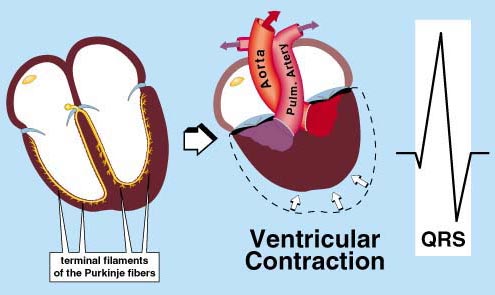
From Rapid Interpretation of EKG's copyright © 2017 COVER Publishing Co. Inc.
The
entire ventricular conduction system consists of rapidly conducting
Purkinje fibers. The terminal filaments of the Purkinje fibers depolarize
the ventricular myocardium, initiating ventricular contraction while
inscribing a QRS complex on EKG.
NOTE:
Remember that the entire ventricular conduction system, i.e., the
His Bundle through the terminal filaments, is composed of Purkinje
fibers.
Depolarization
of the ventricular myocytes (myocardial cells) produces a
 complex on the electrocardiogram and initiates contraction of the
ventricles.
complex on the electrocardiogram and initiates contraction of the
ventricles.
NOTE:
The QRS complex actually represents the beginning of ventricular
contraction. The physical event of ventricular contraction actually
lasts longer than the QRS complex, but we will still consider the
QRS complex as generally representing the occurrence of ventricular
contraction. So the QRS complex is an electrocardiographic recording
of ventricular depolarization, which causes ventricular contraction.
Still with me?
|

|
In
each text sentence, a missing key word is required:
- keeping
conceptual information in focus.
- maintaining
the reader's personal satisfaction of achievement.
- instilling
permanent knowledge - a secure basis for diagnostic judgement.
|

|
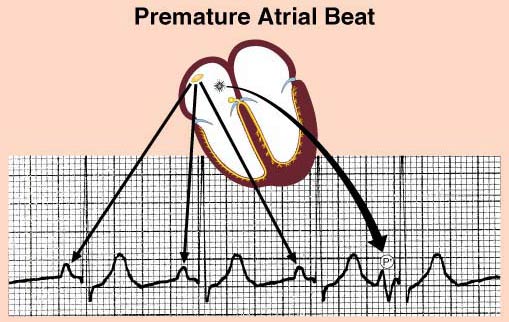
From Rapid Interpretation of EKG's copyright © 2017 COVER Publishing Co. Inc.
A Premature Atrial Beat (PAB) originates suddenly
in an irritable (see previous page) atrial automaticity focus, and
it produces an abnormal P' wave earlier than expected. On EKG, a
P' is atrial depolarization by a focus.
A
Premature Atrial Beat (PAB) originates in an irritable atrial automaticity
focus that spontaneously fires a depolarization stimulus earlier
than the normal  wave on EKG.
wave on EKG.
But
because an atrial focus is the origin of this premature atrial depolarization
(not the SA Node), the stimulus produces a premature and unusually
shaped P' wave* that does not look like a normal Sinus-generated
P  . .
NOTE:
On EKG a PAB records as a P'. The P' may be difficult to detect
when it's hiding on the peak of a T wave; the giveaway is a too-tall
T wave - taller than the other T waves in the same lead.
|
|
Conceptual
associations are linked so:
- understanding
proceeds effortlessly, for smooth learning continuity.
- this continuity
of linked images provides a seamless flow of comprehension.
|

|
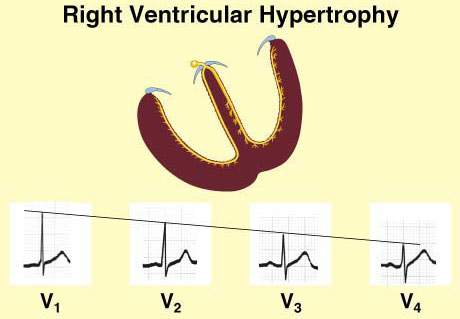
From Rapid Interpretation of EKG's copyright © 2017 COVER Publishing Co. Inc.
With
Right Ventricular Hypertrophy, the large R wave of V1 gets progressively
smaller from V2 to V3 to V4 etc.
When
Right Ventricular Hypertrophy is present, there is a large R wave
in lead
 that becomes progressively smaller in chest leads V2, V3, and V4, as the leads move farther away from the hypertrophied right ventrical.
that becomes progressively smaller in chest leads V2, V3, and V4, as the leads move farther away from the hypertrophied right ventrical.
The
progressive decrease in the height of the  wave is gradual, proceeding from the right chest leads to the left
chest leads.
wave is gradual, proceeding from the right chest leads to the left
chest leads.
|
|
Learning
is easy, and visual imagery lasts a lifetime:
- each visual
concept relates to cardiac function.
- mental images
associated with cardiac physiology become an indelible resource
(unlike the temporary nature of memorized patterns), because…
|

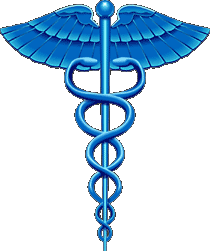 |
This method
of programmed instruction may not suit every scientific discipline,
but the 35-year success of this text is its own best endorsement.
This is the best way for you to learn electrocardiography.
|

Knowledge
of electrocardiography can be yours for a lifetime if you understand
it. Rapid Interpretation of EKG's will make it happen.

|
For over 35 years
(!) Rapid Interpretation of EKG's has been the global best
seller. It is updated with every printing (updated May, 2007):
- the preferred
text for entertaining, easy reading.
- an established
medical classic known for lasting comprehension.
- the most
used, most referenced, and most current of all EKG texts.
- number
one in the United States and world-wide (published in 42 languages),
since first published.
- updated with each printing*,
to keep it the most current EKG text.
|

|
|
Continue > >
|
|
|
Essential
Information for Physicians
Continue > >
|
|
